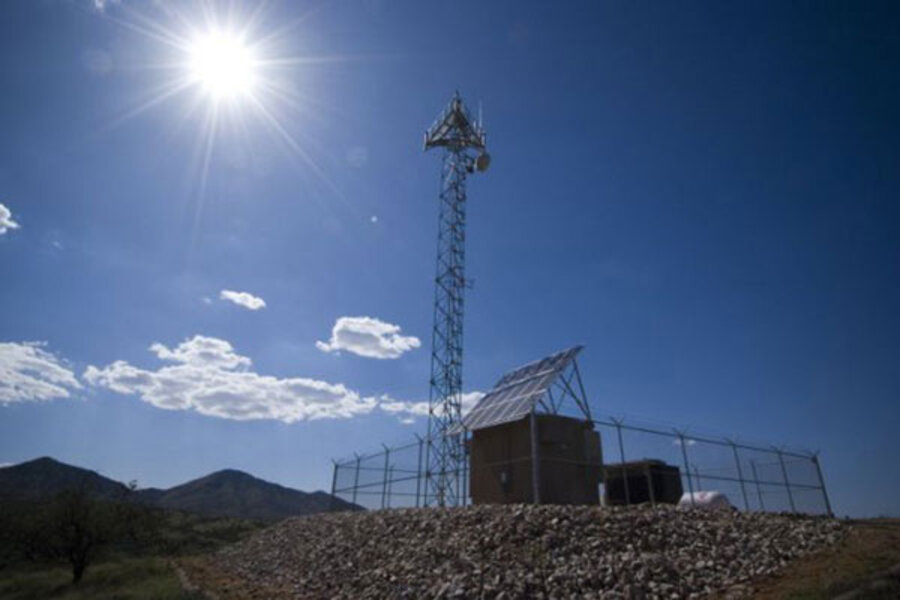US cancels 'virtual fence' along Mexican border. What's Plan B?
Loading...
The dream of a high-tech barrier stretching from one end of America’s southern border to the other – originally hailed by then-President George W. Bush as “the most technically advanced border security initiative” ever – is officially burst.
In announcing that it would pull the plug on the troubled “virtual fence” project, the US Department of Homeland Security (DHS) said Friday it would instead pursue a region-by-region approach, with different parts of the US border protected in different ways as dictated by terrain and other area-specific conditions.
“This new strategy is tailored to the unique needs of each border region, providing faster deployment of technology, better coverage, and a more effective balance between cost and capability,” said DHS Secretary Janet Napolitano in a statement.
RELATED: Could you pass a US citizenship test?
Almost from the onset, the virtual fence – known as the Secure Border Initiative network, or SBInet – ran into problems. As pilot projects were built in two spots in Arizona along the border with Mexico, cost overruns mounted. Just as worrisome was that the technology – in the form of camera-topped surveillance towers that was supposed to pinpoint for border agents in a distant command post the exact location of illegal border-crossers – was often flummoxed by conditions on the ground such as terrain and weather.
“Cameras don’t come down off the poles and grab people by the ankle and arrest them,” T.J. Bonner, president of the National Border Patrol Council representing border patrol agents, told the Monitor in 2009. The technology, he said at the time, was effective only on level ground; in terrain with mountains and valleys it was ineffective beyond a few hundred feet.
In all, the government spent almost $1 billion on the virtual fence project since its inception in 2005, as contractor Boeing Co. endeavored to work out the kinks and refine SBInet’s capabilities. In the end, though, the cost per mile of coverage made it grossly inefficient: It is operational along 53 miles of Arizona’s 386-mile border with Mexico.
By contrast, the DHS expects that security for the rest of Arizona’s border can be buttressed for $750 million, by using commercially available surveillance measures, unmanned drones, thermal imaging, and other equipment.
“SBInet cannot meet its original objective of providing a single, integrated border-security technology solution,” Secretary Napolitano said Friday. It now falls to her department to propose alternative, region-by-region plans for improving border security, which she said would come later this year. In surrendering the “one-size-fits-all” solution offered by the virtual fence, DHS expects to use some of its proven components elsewhere.
The Obama administration has from the beginning made a point of highlighting its efforts to improve border security, knowing it will stand no chance of reforming America’s broken immigration policy unless it demonstrates to Congress and the public that it has first moved aggressively to prevent illegal entry into the US. Indeed, the DREAM Act, a bill to resolve the status of some illegal immigrants already in the US, failed to pass the Senate late last year.
The president, for his part, last year signed legislation to spend $600 million on two more unmanned drones to patrol the border and on 1,500 additional Border Patrol agents and other law-enforcement personnel to crack down on illegal immigrants and drug traffickers. And DHS noted Friday that Border Patrol manpower has doubled – now at a force of 20,500 – since 2004.
Few lamented the demise of the virtual fence project – even those who have criticized the Obama administration for not doing enough to tighten the southern border.
Rep. Peter King (R) of New York, now chairman of the Homeland Security Committee, told The New York Times that the Obama administration should have ended SBInet before now.
Nor did Sen. John McCain (R) of Arizona object to ending the project in his home state. “I am pleased to hear that Secretary Napolitano finally allowed the SBInet contract to expire,” he told The Arizona Republic. “A complete and thorough investigation should be conducted related to this waste.”





